With HDDs On The Ropes, Samsung Predicts SSD Price Collisions As NVMe Takes Over
Samsung's annual Global SSD Summit featured the normal product announcements and presentations outlining the company's latest flash-based advances, but the company also outlined its vision of the current state of the SSD market and future trends. SSDs are steadily displacing HDDs in more applications, but NVMe is shaping up to be the dark horse that may put the venerable HDD to rest.
Samsung has been rather vocal lately about its leading position in the SSD industry and is quick to throw out plenty of claims to underline its dominance, but as a matter of course, we favor independent third-party market reports. We'll cover that later. First, let's look at the trends Samsung identified as the primary industry drivers.
SSD Rumblings As Prices Drop
Samsung loves Google, and not just because it probably buys plenty of its SSDs. Samsung outlined its rather intense focus on Google Analytics for marketing purposes last year, and this year it pointed out that recent Google searches for "SSD upgrades" outweighed searches for "CPU upgrades." The historical trend indicates that this wasn't always the case (of course), but with 40 million searches for SSD upgrades this year, it is clear that SSDs are on the move. Performance stagnation in the CPU market is probably to blame here, as well, and we routinely advise readers to spend their hard-earned dollars on GPU and SSD upgrades before the CPU.
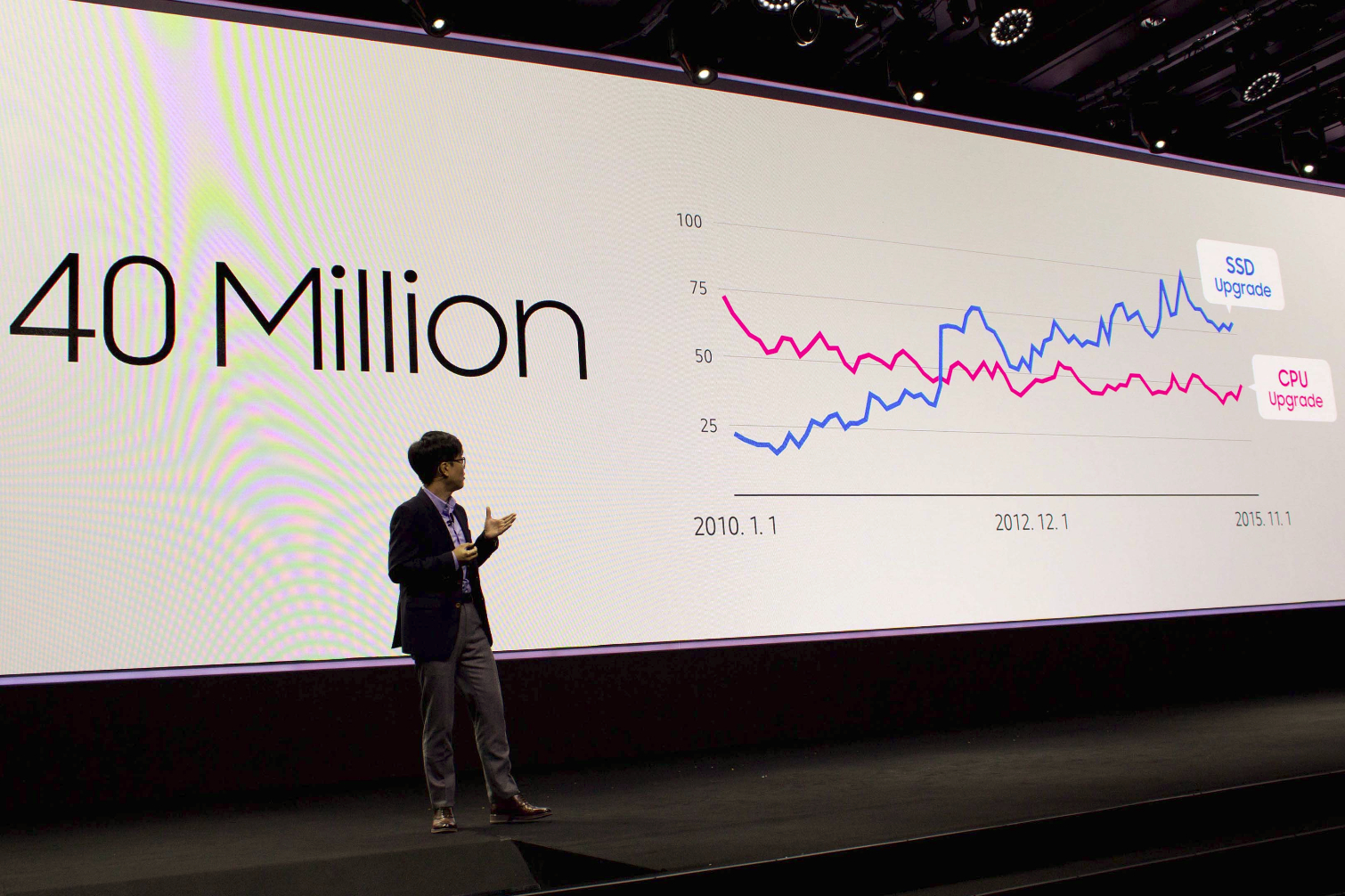
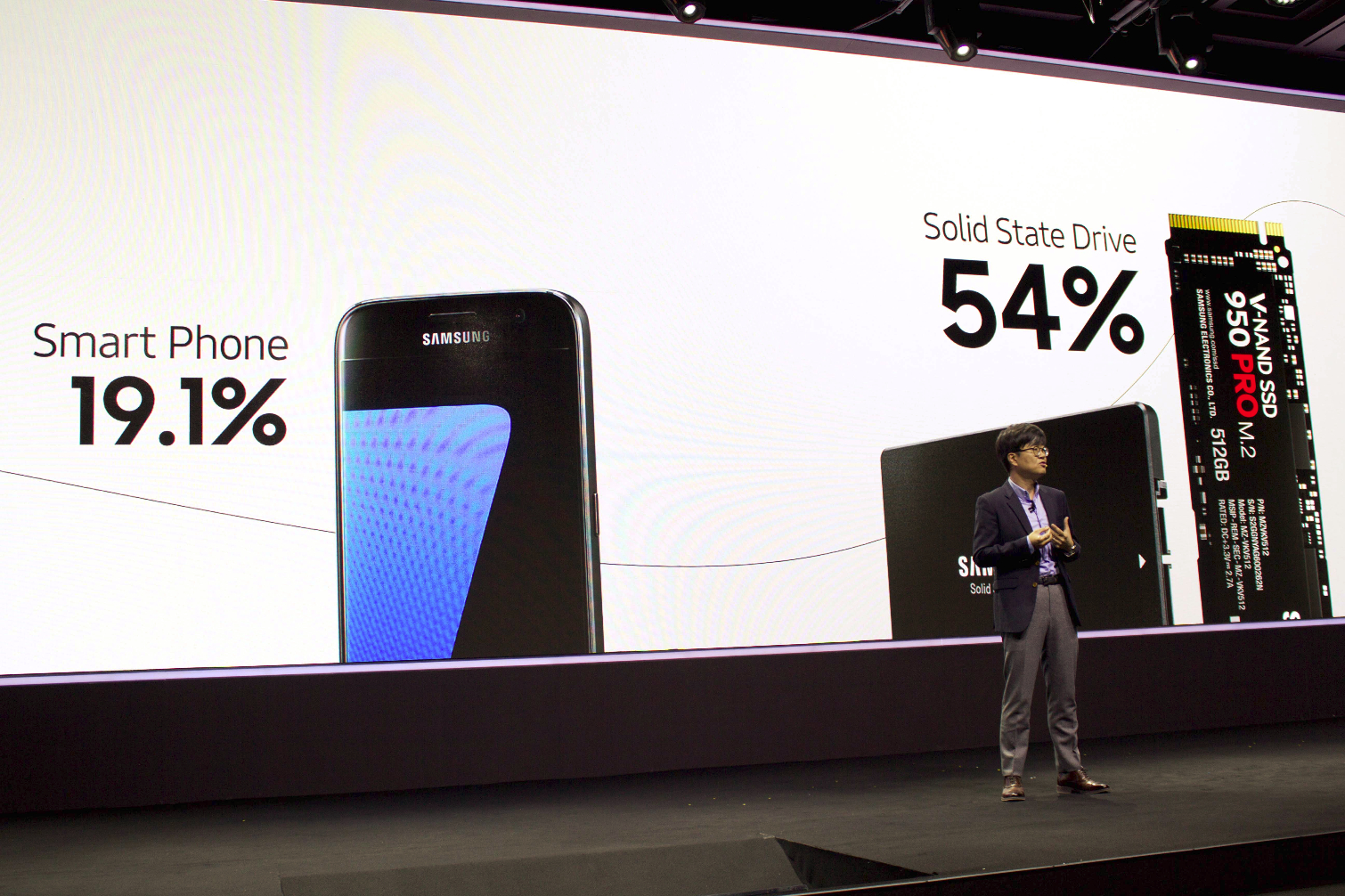
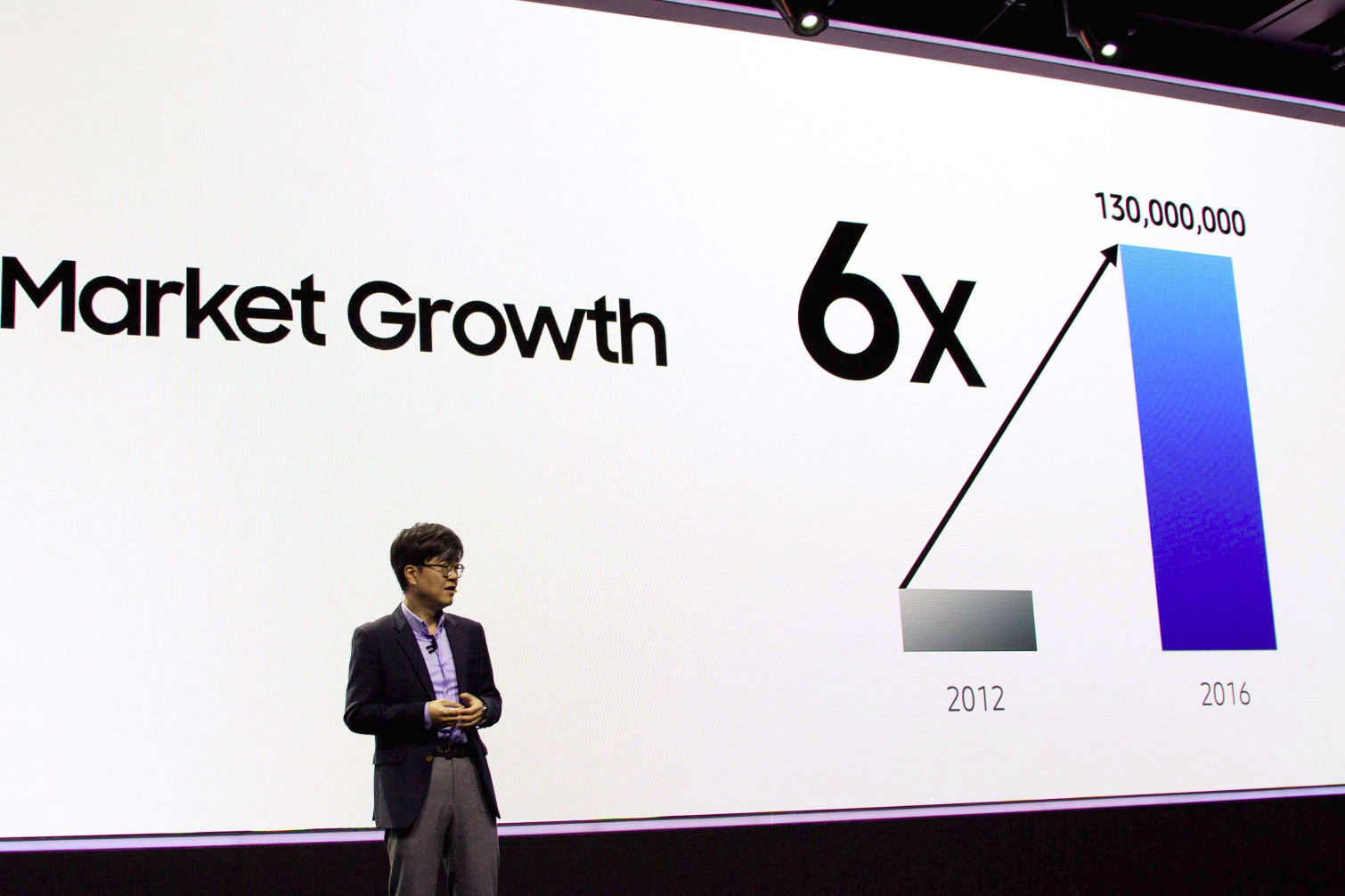
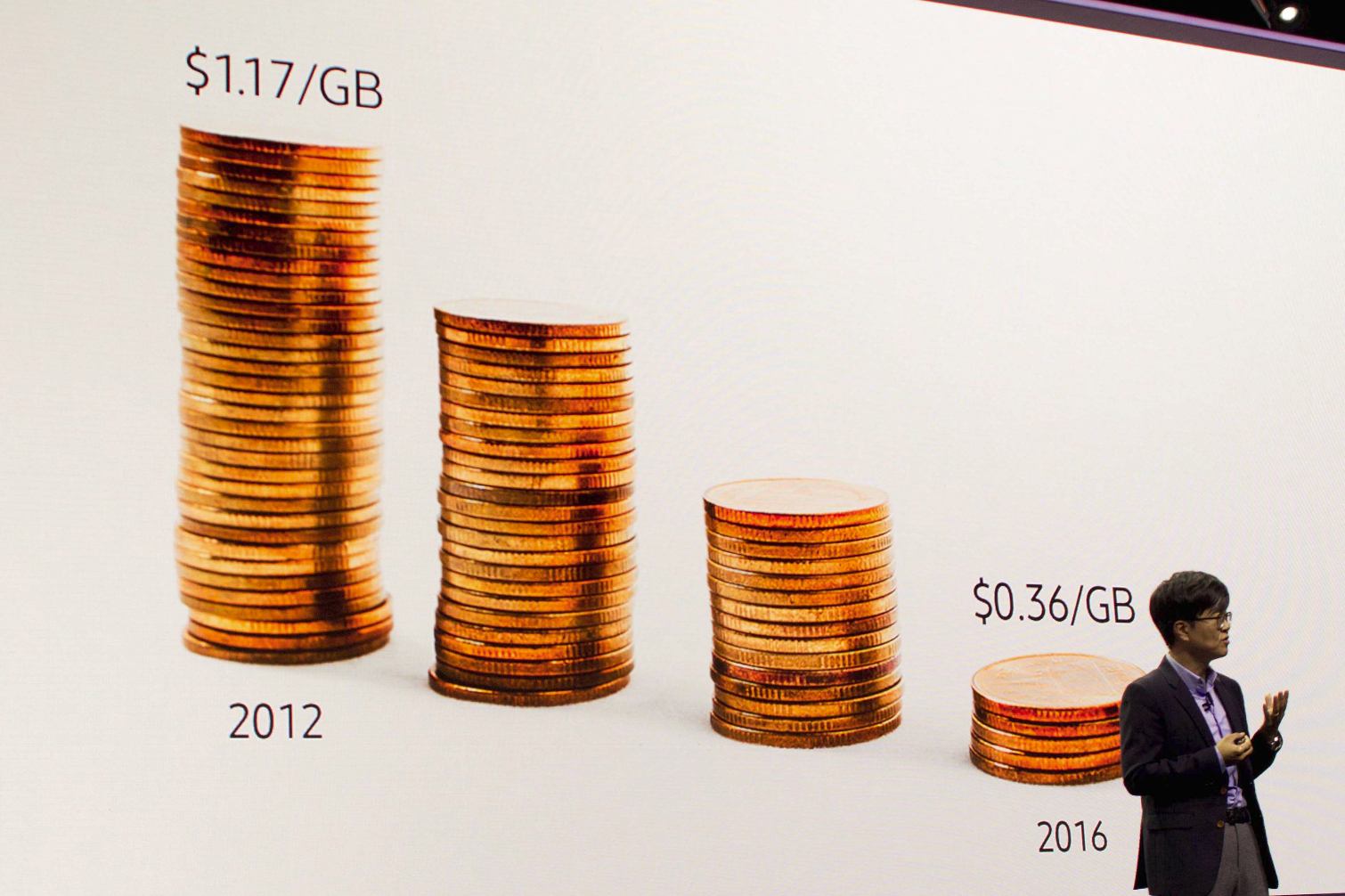

The cellphone industry has long served as the prime example of an explosive growth market; it grew 19.1% in the last five years alone. SSDs, by contrast, grew 54%, and the steady downward pricing slope is a key factor. The all-important price-per-GB fell from $1.17 in 2012 to a mere $0.36 in 2016 (69% reduction). This is an average value, you can find SSDs for even less on the retail market.
The SSD market grew 6x (to 130,000,000) from 2012 to 2016. Samsung's NAND shipments benefit from both the smartphone and SSD industries, and the company presented a chart that highlighted the changing NAND shipment mix. A higher percentage of flash heads into the SSD and Mobile segments every year as the percentage of UFD (USB Flash Drive), cards, and "others" decline.
Mount SSD Spews Forth Capacious SSDs, 3D TLC NAND To Blame
The wave of TLC NAND in both 2D and 3D flavors helps to push pricing down. Samsung cited a Forward Insights (a market analysis firm) report that indicates the industry, as a whole, reached a crossover point this year that sees more TLC NAND making its way to market than MLC NAND. The early days of TLC NAND were ripe with rampant speculation that the less-endurant media wasn't suitable for consumer use, but the naysayers were obviously wrong. Samsung repeated the "TLC is the new MLC" mantra several times at the event, but the real question is when we will transition to saying "QLC is the new TLC."

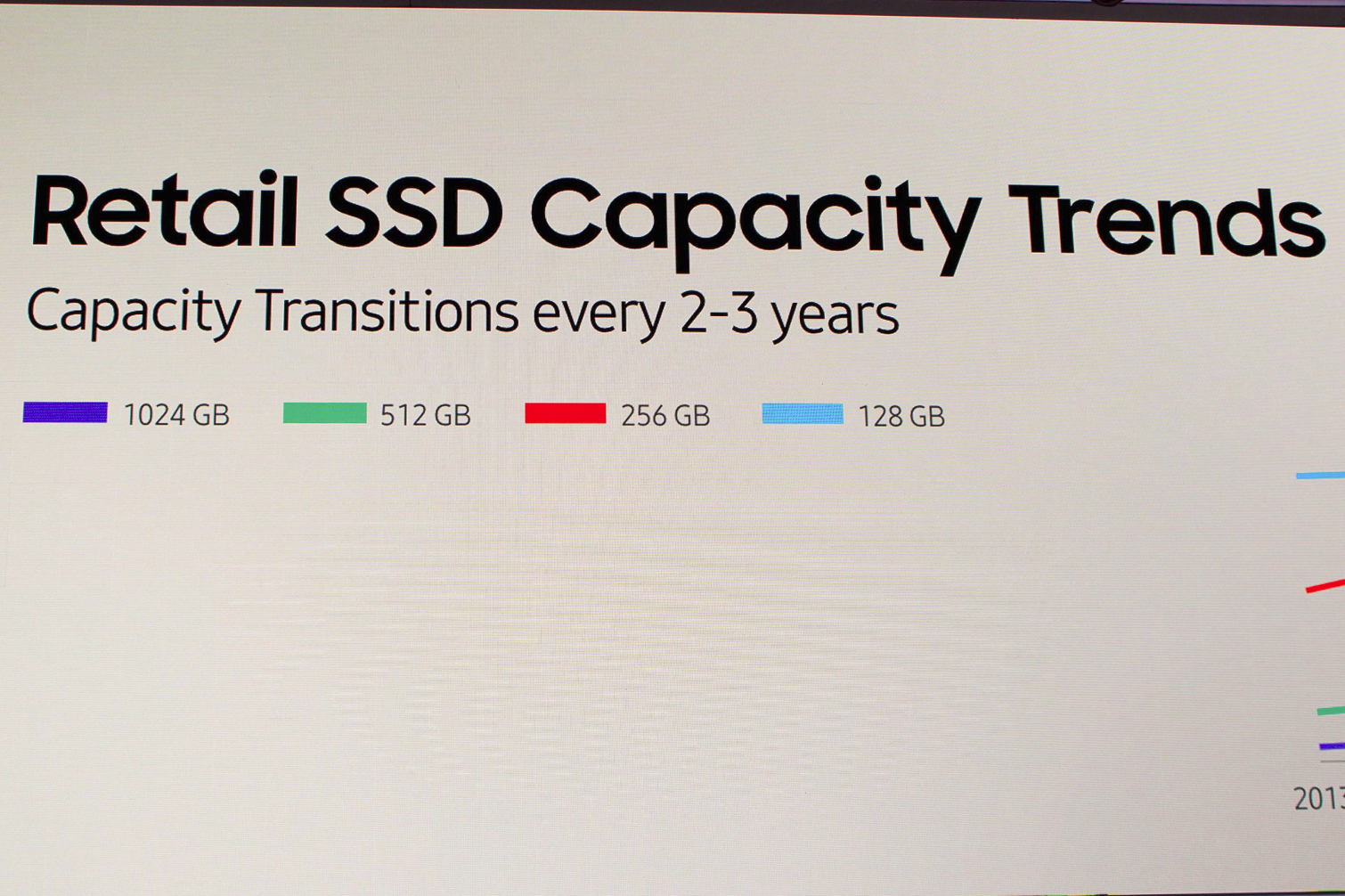
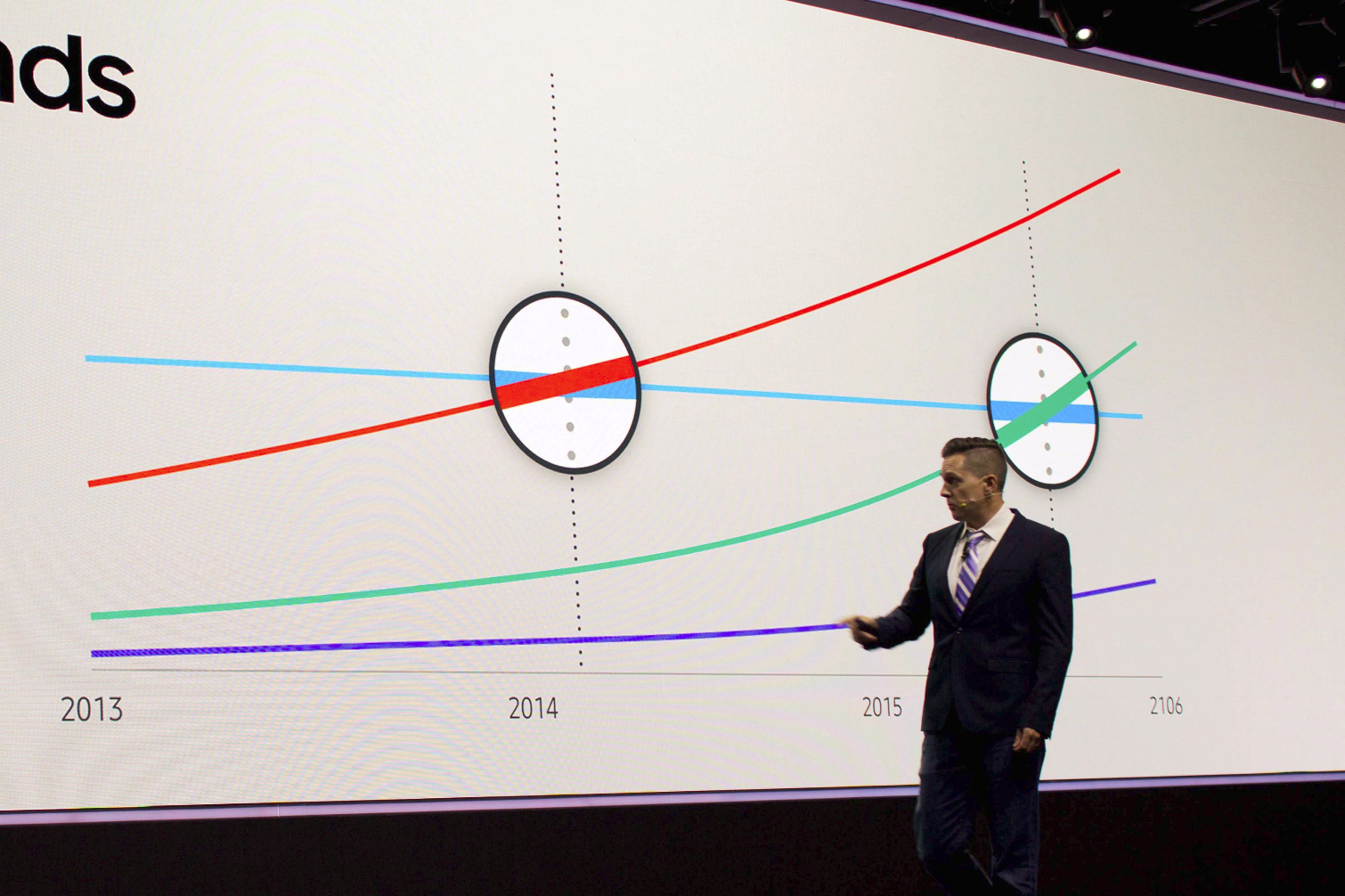
The incessant march of increased density is the driving force behind lower prices. Because higher capacity leads to lower prices, the capacity trends in the retail market serve as a good indicator of the future.
Get Tom's Hardware's best news and in-depth reviews, straight to your inbox.
You'll have to excuse the split charts; Samsung chose to show off its 100 foot-long (well, that's an estimate) LCD (OLED?) screen, so it wasn't possible to get the chart and legend in one frame. The company provided a chart that outlined the recent progression of SSD capacity in the retail market that shows 256GB SSDs became more popular than 128GB models in early 2014, and 512GB surpassed 128GB SSDs in mid-2015.
HDDs On The Ropes
HDDs have a serious pricing problem for low-capacity applications. The majority of notebook users don't need more than 1TB of storage (most need much less), and the rise of the cloud continues to reduce the need for high-capacity local storage. SSDs don't really have to beat HDDs on the price versus capacity front (and they probably never will); the price just needs to be "close enough" to become a viable HDD alternative. The popular 256GB SSD capacity is already close to the price of a 1TB HDD. Samsung predicts that the price of a 256GB SSD will sink beneath 1TB HDDs in mid-2017, and 512GB will follow in 2020.
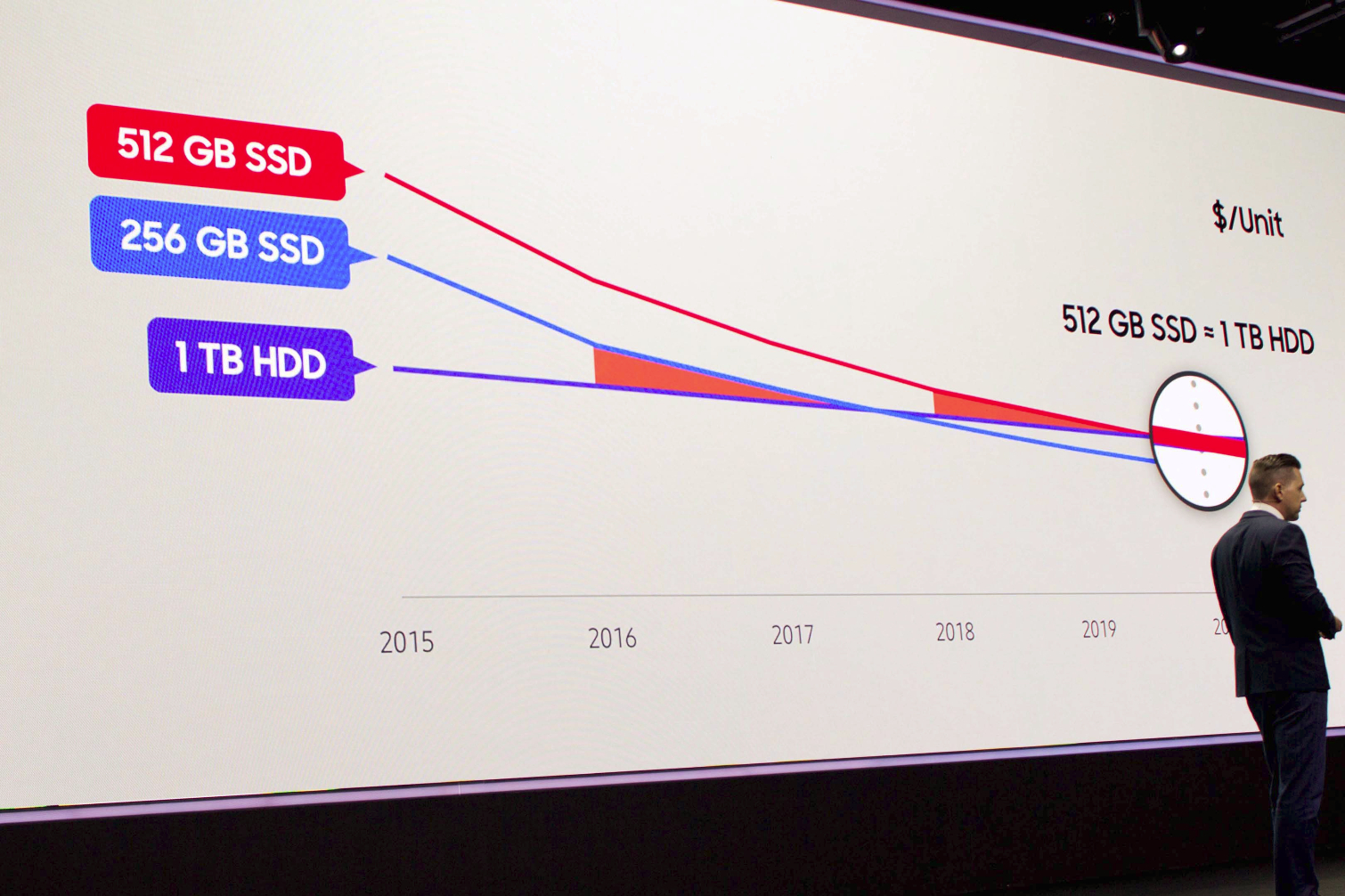

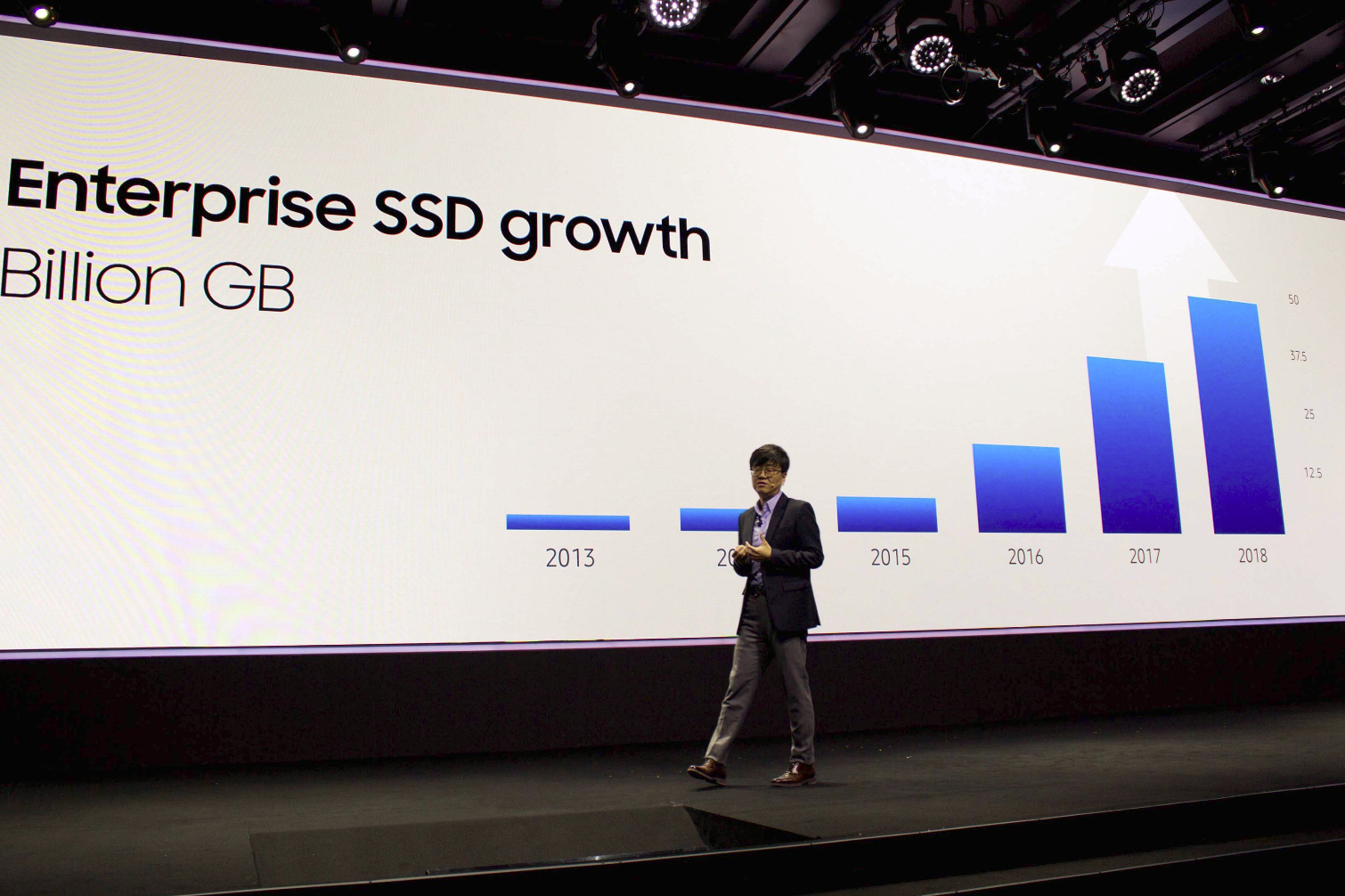
Unfortunately for HDDs, there is roughly a $40 price floor that they simply cannot get under. That's the minimum dollar amount needed to provide the HDD casing, motors, heads, and other components--regardless of how low the capacity is. SSDs can scale well below $40 in smaller capacities, which is important in the cost-sensitive notebook market. SSDs have already displaced HDDs in 40% of new notebooks, and Samsung predicts that it will reach 55% penetration in 2018. Samsung's prediction is slightly lower than other industry estimates, which indicate that 52% of notebooks will have an SSD next year.
More new notebooks ship with SSDs, but only 10% of new desktop PCs come with an SSD (which we've decried before). We asked Samsung why desktop PC penetration is so low and how it plans to gain more share in the PC market. Samsung's Ryan Smith replied that part of the problem is that desktop PCs require more storage, and SSD prices are still too high to penetrate the high-capacity segment. He also noted that Samsung is going to address the high-capacity segment this year.
I suspect QLC SSDs are the answer. Toshiba is already working on QLC SSDs, and third-party QLC SSD controllers are emerging, so it will inevitably have an impact. Whether or not Samsung jumps on the QLC train remains to be seen.
Samsung cut its 3D TLC NAND teeth in the client market, but now that it has scale, it is swiftly taking over the data center with low-priced 3D TLC SSDs. The company ascended to the #1 spot in the enterprise SSD market this year and expects to triple its enterprise SSD output in the next two years. The increased production scale will help push down retail prices, as well.
NVMe Muscles SATA Out Of The Ring
NVMe SSDs are taking over the SSD market at an astounding rate while pushing SATA to the wayside. NVMe SSDs accounted for only 3 million units in 2014 but have skyrocketed to 33 million units this year.
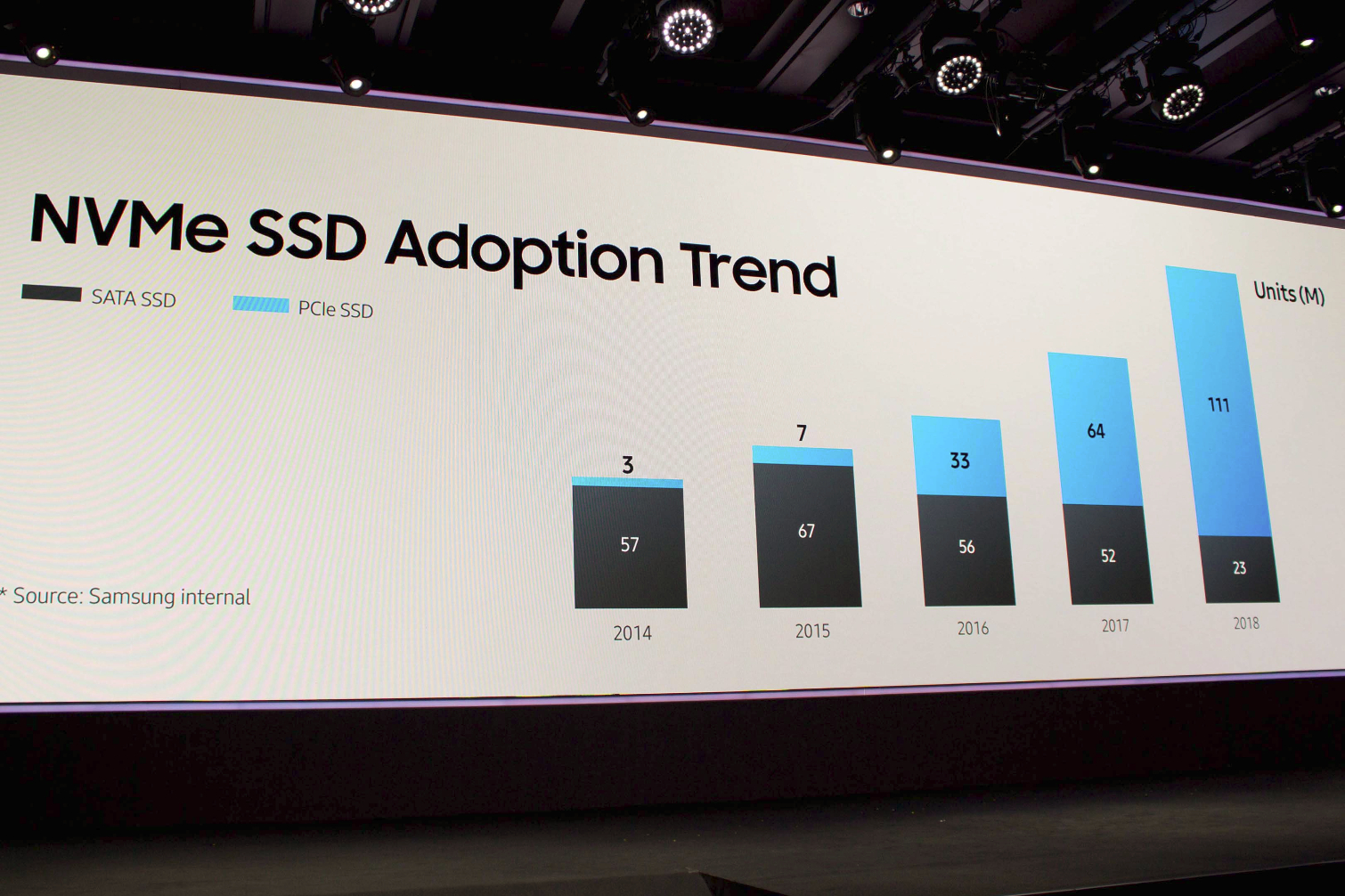
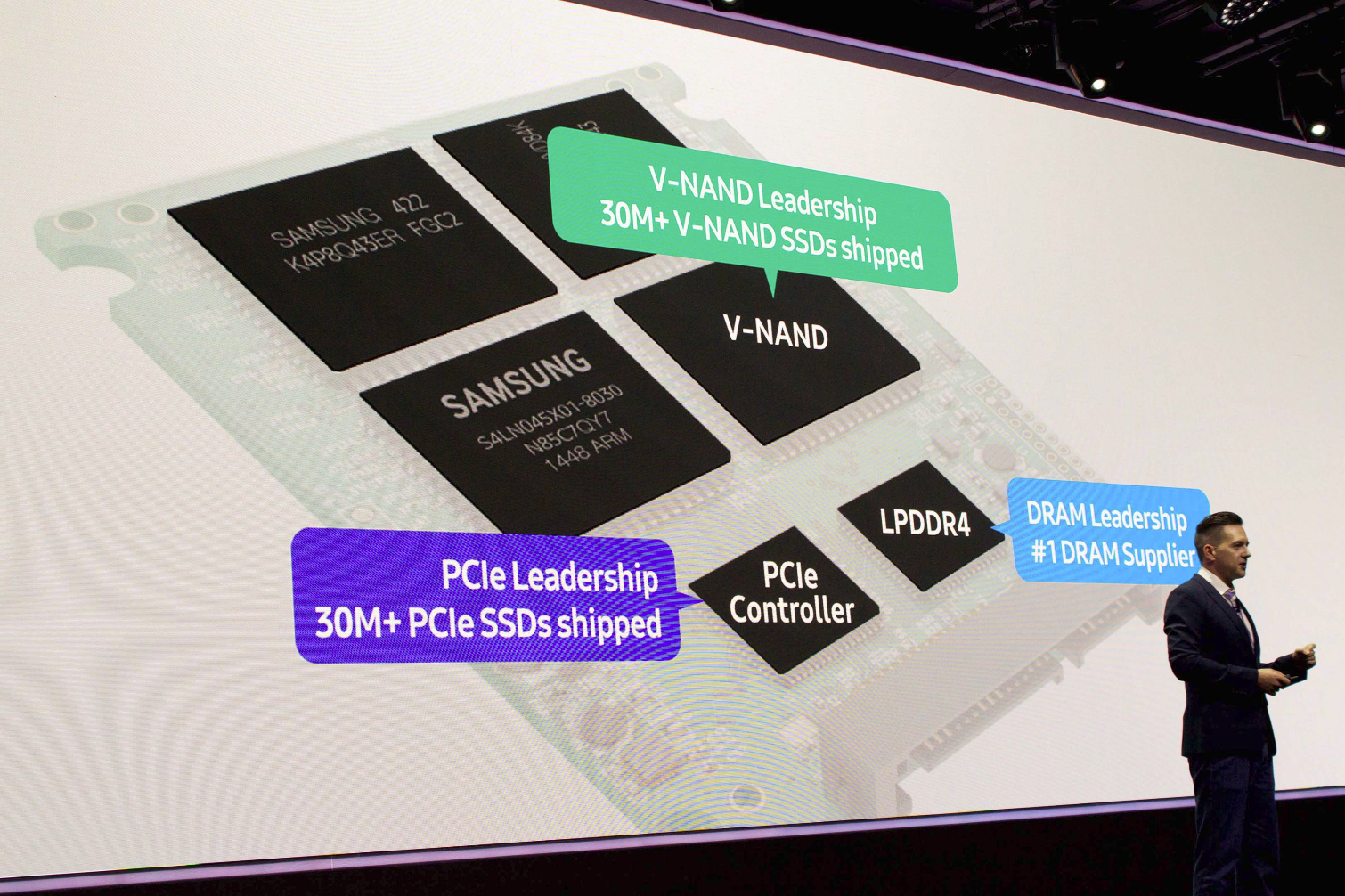
This year was undoubtedly the "breakout" year for NVMe, but Samsung predicts that 2017 will tip the scales entirely in NVMe's favor with 64 million NVMe SSDs outweighing the 52 million SATA SSDs that will hit the market.
Surprisingly, Samsung expects NVMe to account for 111 million units in 2018, which dwarfs the expected output of 25 million SATA SSDs. The venerable SATA interface has hit a performance brick wall, and there is no plan for a new, faster revision. The lack of forward SATA movement will relegate it to the annals of history in the SSD market, though it will likely continue to thrive in the HDD market.
According to Samsung, it will account for half of the 40 million SSDs the industry is expected to ship this year into the retail SSD aftermarket. The company feels uniquely well positioned for the pronounced shift to NVMe over the coming years; it’s already shipped 30 million PCIe SSDs with its proprietary SSD controllers.
So, Samsung Says It's The 900lb SSD Gorilla, But Does The Industry Agree?
The latest independent third-party Trendfocus report (C2'16) indicates that Samsung manufactured 40.8% of all consumer and enterprise SSDs shipped last quarter. The high percentage is impressive, but it is even more impressive when we compare Samsung to the rest of the competition. For a bit of perspective, Samsung's share is more than the next four contenders combined.
Of course, calculating the number of units shipped can be a bit misleading, because SSD capacity varies. The most important ingredient to the fab recipe is scale; he who sells the most capacity wins. If we zoom out and look at the 12.41 exabytes of NAND shipped last quarter, the Samsung lead is even wider at 46.6%. That is more than the next six vendors combined. Notably, Samsung's SSD capacity output is more than all of the other fabs combined.
Competition Looms
Samsung gained much of its lead on the back of its 3D NAND, but that advantage is expiring. Micron recently expanded its Singapore fab, which focuses on 32-layer 3D NAND, by an additional 225,000 square feet. Intel, which participates in the joint IMFT (Intel/Micron Flash Technologies) partnership, also stands to gain from the increased output, but it is also plowing ahead with its own 3D NAND aspirations. Sk Hynix is reportedly ramping up to 48-layer products, which will increase output, and we've already seen its 36-layer 3D NAND in the wild. The Toshiba/WD Flash Forward partnership still lags behind the other fabs, but the company expects significant 3D BiCS volume by mid-2017.
We should expect some serious jockeying in the SSD market over the coming year, but Samsung is turning to other methods to gain a new advantage. 3D NAND is much cheaper to produce than regular planar NAND, but many opine that Samsung isn't passing all of the savings to the consumer, because there hasn't been any serious competition. As more fabs start pumping out 3D NAND, we can expect pricing to plunge even further, which is good for everyone. It may also accelerate other trends, such as the (so far) excruciatingly slow death of the HDD in the consumer market.

Paul Alcorn is the Editor-in-Chief for Tom's Hardware US. He also writes news and reviews on CPUs, storage, and enterprise hardware.
-
redgarl SSD surpass CPU search for upgrades... normal, no new architectures was released this year... dudah!!!!Reply -
InvalidError Reply
Even if both AMD and Intel launched something new, it does not change the fact that most people with a Sandy Bridge or newer won't be swayed by incremental performance increases. My i5-3470 is now four years old and I foresee no reason to even think of upgrading it in the foreseeable future. With my past PCs, four years was the absolute limit before I ran into a hard CPU, memory or IO bottleneck that forced me to upgrade to maintain my sanity.18659457 said:SSD surpass CPU search for upgrades... normal, no new architectures was released this year... dudah!!!!
Sounds like a natural consequence of the general PC market slow-down: most people don't look into upgrades until they need them and mainstream use gives most people few to no reasons to upgrade anymore. -
thundervore I have a 3770K and a Z77 motherboard and 16GB of RAM. I don't see myself upgrading until at least 2020 my motherboard, CPU or RAM.Reply
My SSD however I may upgrade from a 120GB to maybe a 512 NVMe with PCIe express adapter.
Honestly, I have no intention to upgrade until PCIe 4.0, USB 4.0, a new SATA speed standard or new NVMe speed.
I do find it funny how SATA Express came and vanished like a fart in the wind. it was there one second now its like SATA express what? -
Paul Alcorn Reply18659622 said:Only reason you'd upgrade now will be for VR
Funny you mention that, there are some VR-specific SSDs coming to market soon. Probably more marketing than anything, I doubt there are any real VR_specific tweaks, but so it goes.
We need a meme... Brace yourself...VR SSDs are coming.
-
Paul Alcorn Reply18659714 said:I do find it funny how SATA Express came and vanished like a fart in the wind. it was there one second now its like SATA express what?
Yeah, definitely DOA. Power consumption is a big issue with faster SATA, so they abandoned 12Gb/s.
-
3ogdy Reply18659457 said:SSD surpass CPU search for upgrades... normal, no new architectures was released this year... dudah!!!!
:) Yeah, you're right, but it's also the fact that usually a new CPU involves getting new motherboard and probably new RAM too, which is far from the drop-in upgrade the SSD is. One could easily upgrade any computer with a SATA port from a 5.4K/7.2K RPM HDD to an SSD. Capacity doesn't really matter that much if the end-user can keep other HDDs in the system and still enjoy fast boot times and great app response. No wonder people are more interested in SSDs than in upgrading CPU for marginal improvements because thanks Intel and AMD. It's better that way. Older systems enjoy a higher value this way and people spend their money on something else. VR might change things a bit, but it remains to be seen. -
3ogdy Reply18659714 said:I have a 3770K and a Z77 motherboard and 16GB of RAM. I don't see myself upgrading until at least 2020 my motherboard, CPU or RAM.
My SSD however I may upgrade from a 120GB to maybe a 512 NVMe with PCIe express adapter.
Honestly, I have no intention to upgrade until PCIe 4.0, USB 4.0, a new SATA speed standard or new NVMe speed.
I do find it funny how SATA Express came and vanished like a fart in the wind. it was there one second now its like SATA express what?
You're right about interface generations seldom making it worth upgrading rather than marginal IPC improvements no casual PC gamer would really take advantage of.
The SATA Express part, though, LOL...that's so true - they were all over it like "OH WOW WOW WOW, now you can get better performance with this approach and this and that..." Where's the SATA Express adoption? Under the ground. Nobody cared. M.2 FTW, as it seems.
That was, in part, because SATA Express required newer SB / chip implementations - one needed a motherboard that specifically supported SATA Express. In that case, I'd rather go down the M.2 path.
SATA's death is not necessarily imminent, as SSD prices are still stupidly high. They're still absurd, especially compared to HDDs, but nevertheless even without the comparison, these things aren't cheap for the capacity. Not in a world where everyone upgrades codecs and increases resolutions and games become bigger, video files become huge and so on. That's what HDDs are betting on: further file size increases that can give them an edge over SSDs, in $/GB ratio. Let's not forget data stored on flash is apparently not that easily recoverable as data from magnetic media seems to be (if "easily" is even the right adverb for this) -
3ogdy Reply18659747 said:18659622 said:Only reason you'd upgrade now will be for VR
Funny you mention that, there are some VR-specific SSDs coming to market soon. Probably more marketing than anything, I doubt there are any real VR_specific tweaks, but so it goes.
We need a meme... Brace yourself...VR SSDs are coming.
Exactly. Everyone and their momma wants a piece of the hot cake that SSDs seem to be now.
VR SSDs, Triple Screen SSDs, Pokémon SSDs, Anti-NSA SSDs, Pope-Optimized SSDs with the Pope's golden signature on them for the ones who listen to religious music and pray all day long. They come white but the more pornography one watches and the more piracy one is involved in, they get darker and darker until they burn, just like one's soul would burn in hell for such incredible sins.
I'd be surprised if Trump and Clinton don't end up having their own SSD models on the market, for duck's sake.
-
quilciri Reply18659457 said:SSD surpass CPU search for upgrades... normal, no new architectures was released this year... dudah!!!!
The actual reason has been brewing much longer than that. There hasn't been a major jump in CPU performance since sandy bridge, nor has there been much consumer need for more performance.
Also, Kaby Lake is due out Q4, machines are already available for pre-order.
*edit* just now noticed InvalidError essentially posted my answer. repped :)
